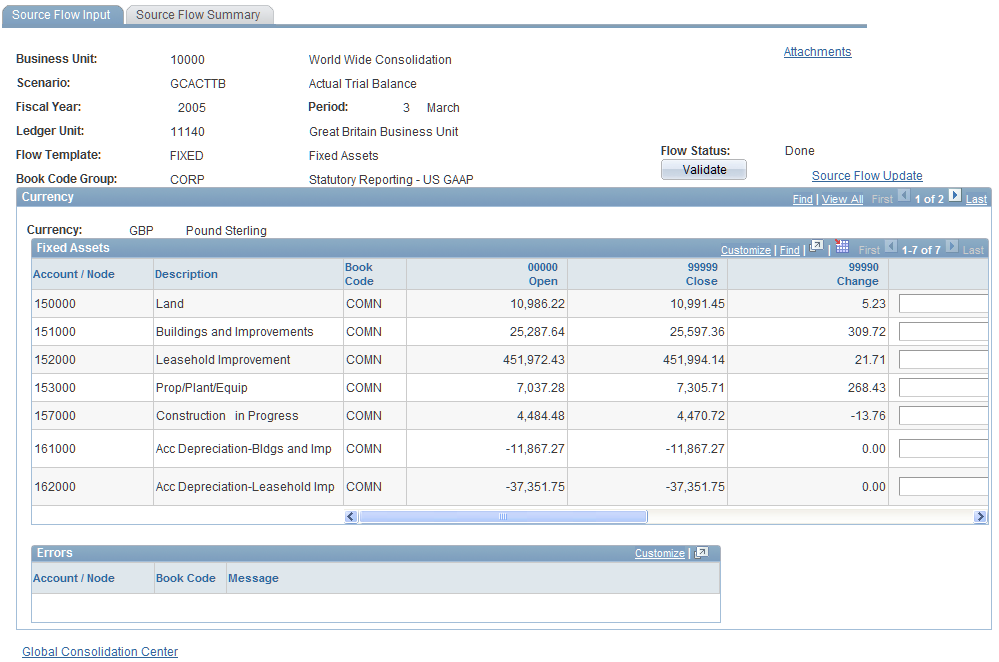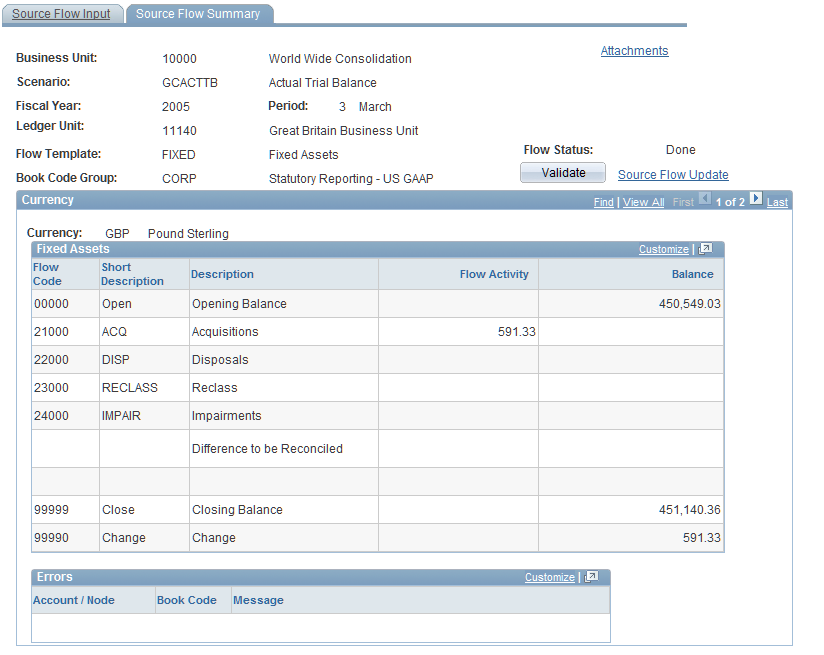Managing Source Flow Inputs
This section provides an overview of source flow input amounts and discusses how to:
Enter Source Flow Input amounts.
Review the Source Flow Summary.
Pages Used to Manage Source Flow Input Amounts
|
Page Name |
Definition Name |
Navigation |
Usage |
|---|---|---|---|
|
Source Flow Input |
GC_FLSRC_IN |
|
Review the manual and system flow code amounts, change and add manual flow amounts, and monitor opening and closing balances for the source consolidation ledger |
|
Source Flow Update Run Control |
GC_FLSRC_RUN |
Click the Source Flow Update hyperlink on the Flow Source Input page. |
Run control page to start the Source Flow Update process. |
|
Flow Attachment |
GC_FLSRC_ATT |
Global Consolidations, Prepare Data for Consolidation, Process Flows for Source Data, Source Flow Input,Attachment |
Attach supporting documentation |
|
Source Flow Summary |
GC_FLSRC_SMY |
|
Review the open and close balances for the template and total flow activity. |
Understanding Source Flow Input
Use the Source Flow Input page to enter and review flow amounts for the source balances that are brought in to the consolidation ledger by the ledger preparation process. For each manual flow template that you establish to work with your consolidation model, you can review, change, and add source flow amounts for manual flow codes on the Source Flow Input page. The manual flow template establishes which accounts and flow codes are displayed on the Source Flow Input page.
This example shows the Source Flow Input page for the Fixed Assets template. The Account, Description, and Book Code are all derived from the values specified on the Fixed Assets manual flow template. The amounts in the Open, Close, and Change columns are all derived using the system flow codes specified on the Fixed Assets manual flow template. The columns for ACQ (acquisition), DISP (disposition), Reclass (reclassification), and Impair (impairments), are used to enter actual amounts for the manual flow codes associated with the Fixed Assets template. Because source amounts for the manual flow codes cannot be extracted by the system, you must enter them manually.
After source flow input amounts are entered and validated, you update the flow activity record by running the Source Flow Update process.
You can also use spreadsheets to upload source and journal flow amounts.
See Using the ExcelToCI Spreadsheet Upload Facility.
Source Flow Input and Ledger Format
When defining ledgers, you select one of these formats: trial balance or financial statement. The way the balances are stored and how the consolidation entries are recorded differ for each format, so the Source Flow Input page also differs depending on what Global Consolidations sources are used to derive the opening and closing balances.
See Understanding Ledger Templates.
This table explains the differences in the Source Flow Input page, depending on whether you are using the trial balance or financial statement ledger format:
|
Balance |
Trial Balance Ledger Format |
Financial Statement Ledger Format |
|---|---|---|
|
Opening Balance |
Derived from the consolidation ledger for the fiscal year selected and the summation of accounting periods zero through the period selected minus one. Comprised of GC sources from source balances (01, 1A) and close process entries (9A-9D). |
Derived from the consolidation ledger for the fiscal year selected and the accounting period selected minus one. Comprised of GC sources from source balances, manual journals (03), equitization entries (05's, allocations (07's), and close process (09's) entries. |
|
Closing Balance |
Derived from the consolidation ledger for the fiscal year selected and the summation of accounting periods zero through the period selected. Comprised of Global Consolidations sources from source balances (01, 1A) and close process entries (9A-9D). |
Derived from the consolidation ledger for the fiscal year and accounting period selected. Comprised of Global Consolidations sources from source balances (01, 1A) and close process entries (9A-9D). |
|
Change |
Derived from the closing balance less the opening balance. |
Derived from the closing balance less the opening balance. |
Note: When using the financial statement ledger format, if the period selected is the first period, then the opening balance will be derived from the last period of the previous fiscal year.
Source Flow Input Page
Use the Source Flow Input page (GC_FLSRC_IN) to .
Image: Source Flow Input
This example illustrates the fields and controls on the Source Flow Input. You can find definitions for the fields and controls later on this page.

You enter source flow amounts (also called inputs) for a manual flow template in the source currency by ledger business unit. If book code functionality has been turned on at the system level, then you enter source flow amounts by book code for that ledger business unit.
The Source Flow Input page lists the opening, closing, and change amounts for the accounts specified on the selected flow template. The opening and closing balances are derived from the consolidation ledger from the source in the source currency. In the manual flow code columns, review, change, and add flow amounts that tie to the change amount.
Source Flow Summary Page
Use the Source Flow Summary page (GC_FLSRC_SMY) to review the open and close balances for the template and total flow activity.
Image: Source Flow Summary page
This example illustrates the fields and controls on the Source Flow Summary page. You can find definitions for the fields and controls later on this page.

The Source Flow Summary page lists the flow code, short description and description. This page allows you to review the opening and closing balances in total for the template as well as the total flow activity.
Using Spreadsheets to Upload Source and Journal Flow Data
In addition to entering flow amounts manually, you can also enter source and journal flow amounts using the spreadsheet upload process.